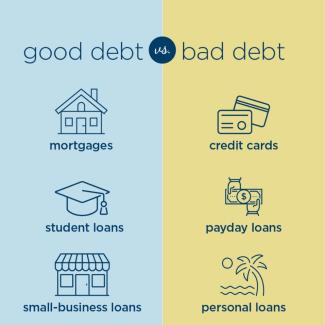
Good Debt vs. Bad Debt: What’s the Difference (and Why It Matters)
Most of us have some form of debt—whether it’s a mortgage, student loan, or credit card balance. Debt has become a normal part of managing money. But not all debt is created equal. Some types can actually help you build wealth, while others can quietly chip away at your financial security.
So how do you tell the difference? Let’s take a closer look.
What is “Good” Debt?
Good debt is money you borrow that helps improve your financial position in the long run. It’s typically tied to an investment that has the potential to grow in value or increase your earning potential.
Buying a home
A mortgage is a classic example. Real estate generally appreciates over time, and each mortgage payment builds equity in your property. For many Canadians, it’s a cornerstone of long-term wealth building.
Investing in your education
Student loans can be worth it if they lead to a career with strong earning potential. They’re often considered good debt—so long as the degree adds value and the repayment terms are manageable.
Starting or growing a business
Borrowing to build a business can be a smart move if the return outweighs the cost of borrowing. Business loans, when used strategically, can help generate new income and create long-term value.
What is “Bad” Debt?
Bad debt is typically high-interest debt used to buy things that don’t increase in value—or even lose value over time. It doesn’t build wealth and can make it harder to reach financial goals.
Credit card debt
Carrying a balance month to month means paying high interest (often 20% or more). If you’re only making minimum payments, this kind of debt can become a long-term burden.
Payday loans
Short-term payday loans often come with extremely high interest rates and fees. They’re one of the most expensive forms of borrowing and can quickly lead to a cycle of debt.
Overspending on vehicles
It’s easy to take on a large auto loan, but cars depreciate quickly. If you’re borrowing more than necessary or stretching payments too far, this type of debt can put pressure on your finances.
Can “Good” Debt Become Bad?
Absolutely. Even smart borrowing can backfire if it’s not managed properly. Taking on a mortgage you can’t afford or student loans that don’t align with your career goals can turn into long-term financial stress.
That’s why it’s so important to borrow with a clear plan. Ask yourself:
- Will this improve my financial situation over time?
- Can I comfortably afford the payments?
- Is this supporting my long-term goals?
Tips for Managing Debt Wisely
Regardless of the type of debt, these tips can help you stay in control:
- Know your interest rates – Focus on paying down high-interest debt first.
- Pay more than the minimum whenever possible.
- Avoid financing wants instead of needs.
- Keep your credit score healthy by paying bills on time.
- Check in with an advisor if you're unsure how to balance debt repayment with other goals.
Final Thoughts
Debt is a tool—and like any tool, it depends on how you use it. The right kind of debt can help you build a future, but the wrong kind can hold you back. Understanding the difference is the first step toward using debt to your advantage.
If you’re unsure where your debt stands or how to tackle it strategically, talking to a financial professional can bring clarity and help you move forward with confidence.

